The Synology DiskStation DS1525+ network-attached storage (NAS) server, first available in the US on June 25 is arguably the best among Synology’s new and controversial 2025 releases.
Here’s the bottom line: The contentious storage requirement aside, the DS1525+ is an excellent NAS server to buy today, worth its $799.99 retail price (diskless). This five-bay server will make it worth the extra total cost of ownership compared to the slightly lesser previous model. However, if you already have the DS1522+, which is excellent in its own right, there’s no need to rush to upgrade, especially if you already added 10Gbps to it.
Dong’s note: I first published this post as a preview on Jun 25, 2025, when the DS1525+ was announced, and updated it to an in-depth review on July 15 after thorough hands-on testing.
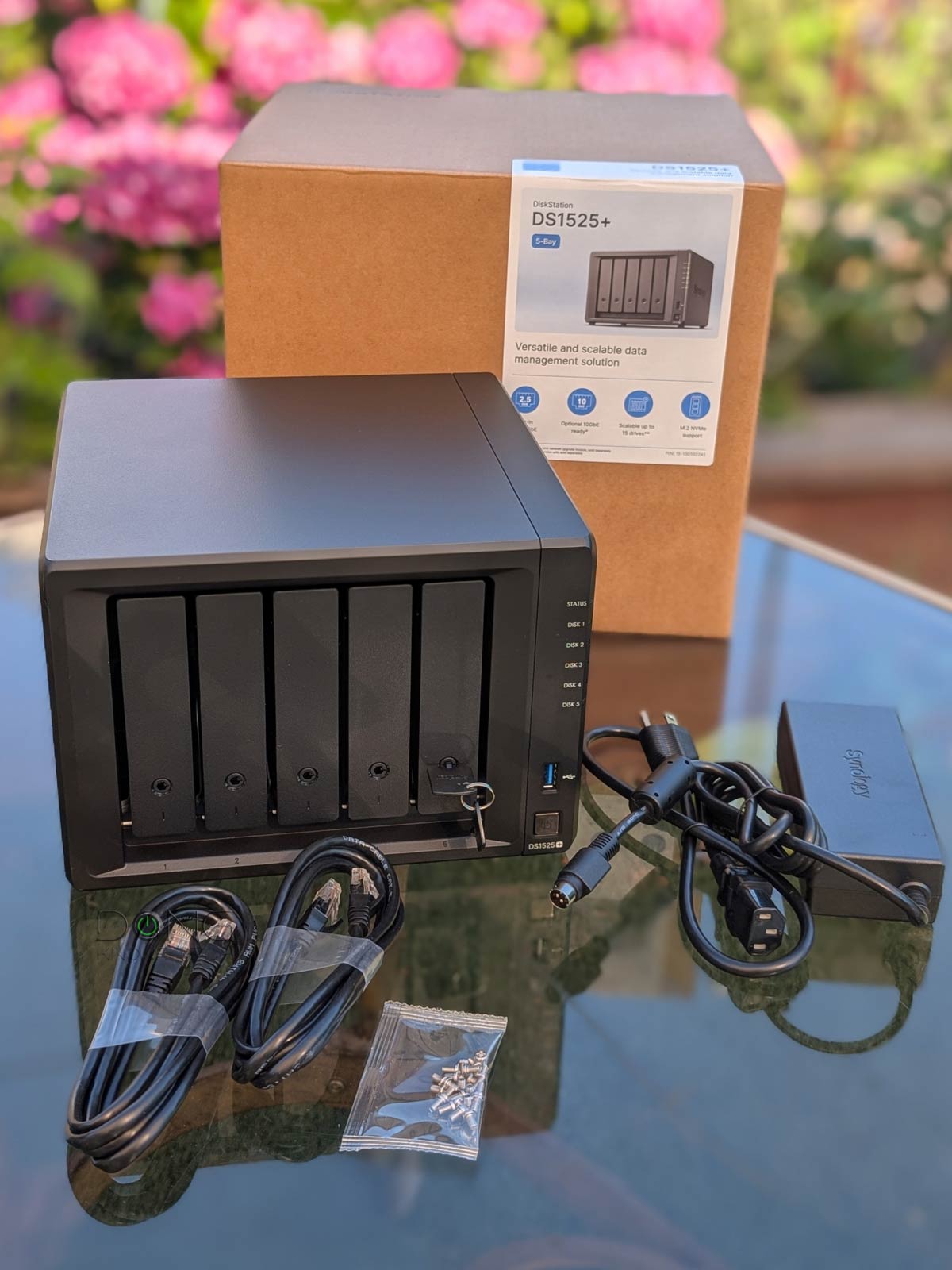
Synology DS1525+: Dual 2.5GbE ports with 10GbE upgrade option
The first thing to note about the DS1525+ is that, like all 2025 Plus models, it comes with Synology’s new storage requirement. It won’t work with third-party drives that are not on the approved list. To put it bluntly, you’ll generally have to get Synology-branded hard drives and SSDs before you can make use of your new server.
Synlogy HCL policy update
At the beginning of 2025, Synology implemented a strict hardware compatibility requirement, known as the 2025 storage lock-in HCL policy, causing its 2025 NAS servers to work only with Synology’s approved storage devices, namely its expensive self-branded drives.
On October 7, 2025, in response to public outcry, Synology released DSM 7.3, which walks back the storage lock-in policy and allows its servers to use third-party SATA drives again, as was the case prior to 2025.
With that out of the way, the new server’s name means it features five native drive bays to accommodate up to five internal drives, as well as the option to host two expansion units, allowing for a total of 10 additional drives. In all, it can handle a few hundred terabytes of storage space when fully loaded.
Similar to the previously announced DS925+, the DS1525+ also utilizes a USB-C port for storage expansion and requires the new DX525. Its USB-C expansion ports feature USB 3.2 Gen 1 (a.k.a. USB 3.0), which caps at 5Gbps. It’s a bit disappointing that Synology doesn’t use Thunderbolt or a faster USB grade for them.
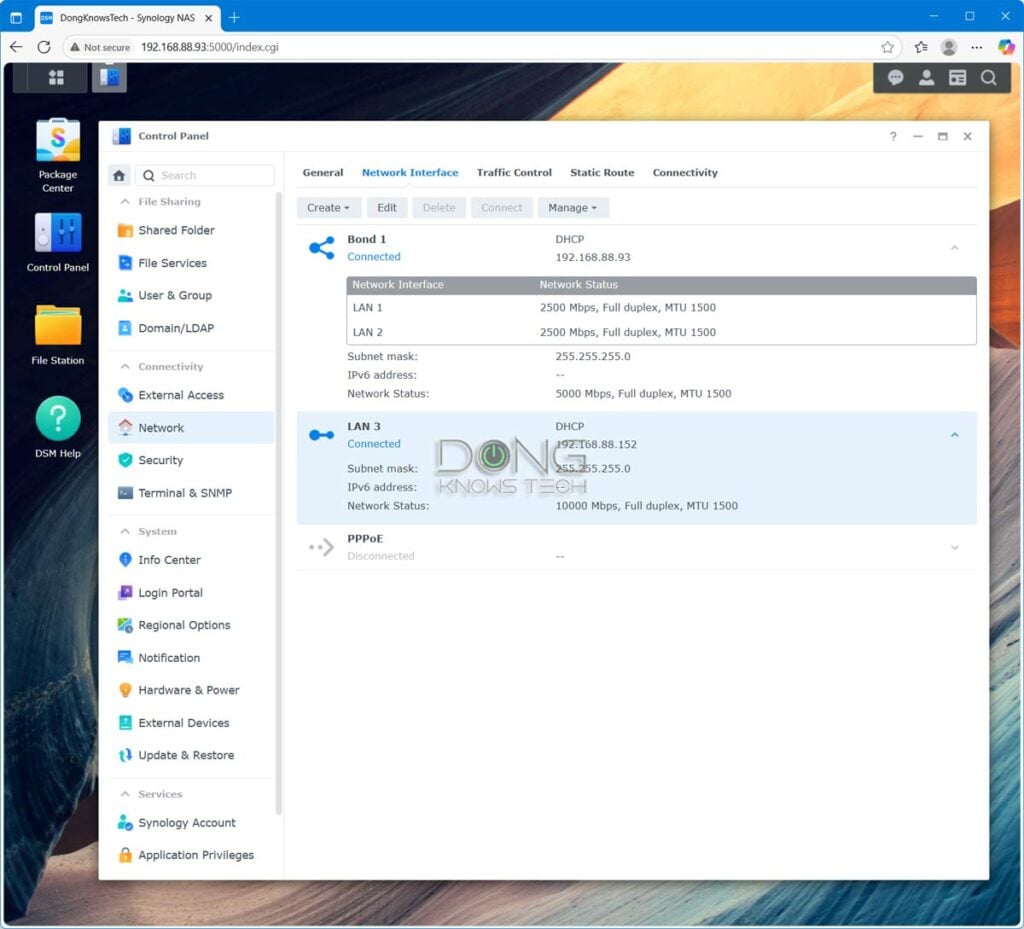
In terms of network connectivity, the DS1525+ represents a significant upgrade from its predecessor. It forgoes Gigabit entirely and instead comes with two 2.5GbE ports. You can even use these two ports in a link aggregation setup to create a 5Gbps bonded link. Additionally, like the case of the DS1522+, it also features a Network Upgrade slot that can accommodate a Synology E10G22-T1-Mini module, quickly adding 10Gbps capability.
Physically, the new server retains the design that’s been consistent in all previous DS15xx+ servers. The cabinet below illustrates the evolution of this lineup over the years since the first DS1511+ was released in 2011.
Synology DS15xx+ servers in brief
| DS1525+ | DS1522+ | DS1520+ | DS1517+ | DS1515+ | DS1513+ | DS1511+ | |
|---|---|---|---|---|---|---|---|
| Model Year | 2025 | 2022 | 2020 | 2017 | 2015 | 2013 | 2011 |
| Gigabit Port | none | 4 | |||||
| Multi-Gig Port | 2x 2.5GbE | None | |||||
| Dimensions | 16.6 x 23 x 22.3 cm | ||||||
| Weight | 2.67 kg | ||||||
| USB Port | 2x USB 3.0 | 2x USB 3.0 | 2x USB 3.0 | 4x USB 3.0 | 4x USB 3.0 | 2x USB 3.0, 4x USB 2.0 | 4x USB 2.0 |
| Expansion Port | 2x USB-C (USB 3.0) | 2x eSATA | |||||
| CPU | 2.2 GHz AMD Ryzen V1500B Quad-core (8 Threads) | 2.6 GHz AMD Ryzen R1600 Dual-Core (4 Threads) | 2.0GHz Intel Celeron J4125 Quad-Core | 2.4 GHz Intel Atom C2538 Quad-Core | 2.4 GHz Intel Atom C2538 Quad-Core | 2.13 GHz Intel Atom Dual Core | 1.8GHz Intel Daul-Core |
| RAM | 8GB (Expandable to 32GB) | 8GB (Expandable to 20GB) | 2GB (Expandable to 16GB) | 2GB (Expandable to 4GB) | 1GB (Expandable to 3GB) | ||
| Built-in NVMe M.2 slot | 2 (caching or storage) | None | |||||
| PCIe slot (upgrade) | None | 1 x 8-lane PCIe slot | None | ||||
| Upgrade Options | 10Gbps module | None | Add-on cards | None | |||
Compared to the immediately preceding model, the DS1522+, the DS1525+ is mostly identical, except for its CPU, expansion unit, and network ports. The table below shows the hardware specs of the two.
Synology DS1525+ vs. DS1522+: Hardware specifications
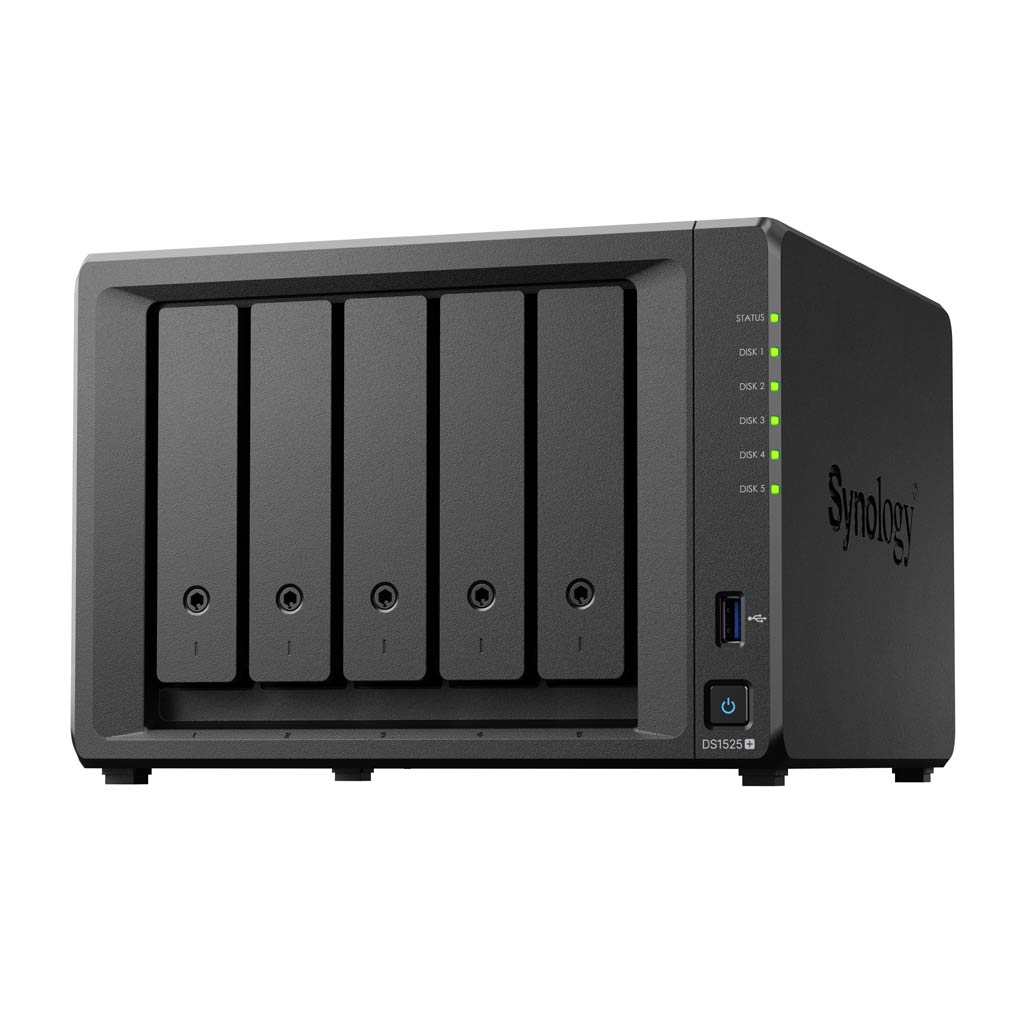 | 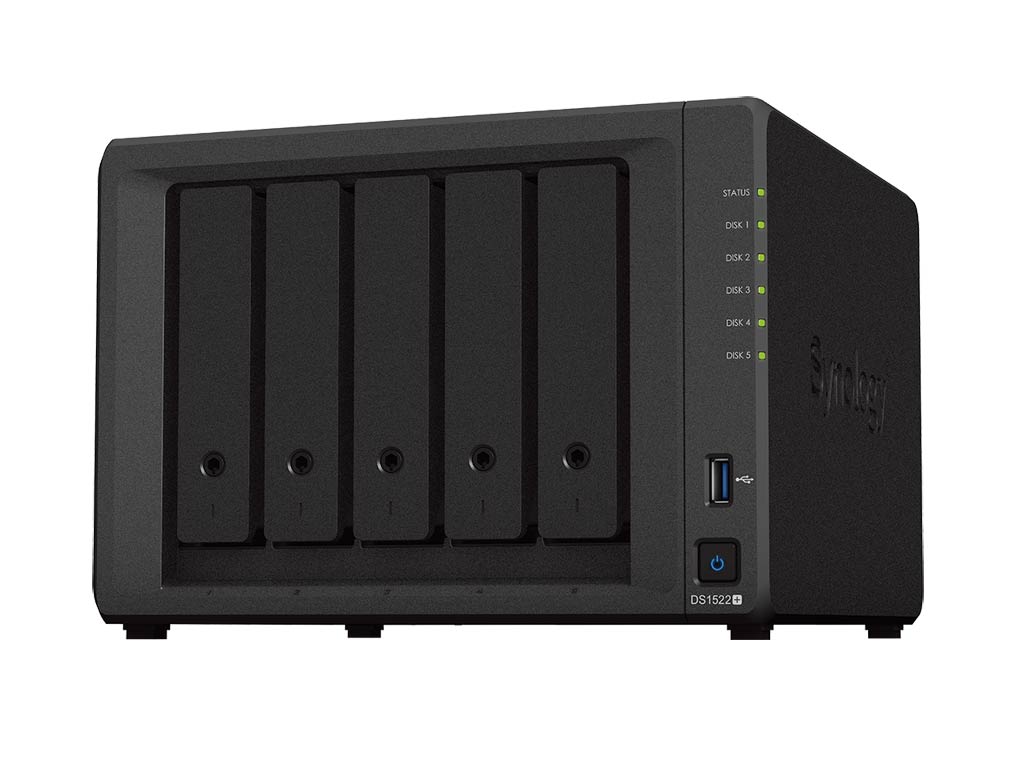 | |
|---|---|---|
| Synology DS1525+ | Synology DS1522+ | |
| CPU | AMD Ryzen V1500B Quad-core 2.2 GHz, 4 Cores / 8 Threads | AMD Ryzen R1600 Dual-core 2.6GHz / 3.1 GHz (turbo), 2 Cores / 4 Threads |
| System Memory | 1x 8 GB DDR4 ECC SODIMM (installed in one of the two memory slots) | |
| Max Memory | 32GB (16GB x 2) | |
| Dimensions | 6.53 x 9.05 x 8.78 in (16.6 x 23 x 22.3 cm) | |
| Weight | 5.88 lbs (2.67 kg) | |
| Drive Bays (native) | 5 | |
| Expansion Support | Yes (2 x DX525) | Yes (2 x DX517) |
| Expansion Connection | USB-C | eSATA |
| Drive Interface | SATA 6Gbps/3Gbps (hot-swappable) | |
| Built-in M.2 Slots (NVMe) | Two | |
| Drive Support | 3.5″ SATA HDD 2.5″ SATA SSD/HDD M.2 2280 NVMe SSD (cache & storage) | |
| RAID Types | Hybrid RAID (SHR), Basic, JBOD, RAID 0, RAID 1, RAID 5, RAID 6, RAID 10 | |
| Max Volume Size | 108TB, 200TB (with 32GB of RAM) | 108TB |
| Max Internal Volume Number | 32 | 64 |
| Max SMB Connections | 40 | |
| Max Shared Folder Sync Tasks | 8 | |
| Max Synology Chat Users | 150 | |
| Max Synology Drive / Office Users | 80 | |
| VPN Server – Max Connections | 8 | |
| Max IP Cameras Support (two licenses included for non-Synology cameras) | ≈ 40 | |
| Ports | 2 x 2.5GbE LAN, 2 x USB Gen 1 ports, 2 x USB-C ports (for expansion) | 4 x 1GbE LAN, 2 x USB Gen 1 ports, 2 x eSATA port (for expansion) |
| Expansion Slot | Network Upgrade slot | |
| Add-on Card (not included) | 10GbE E10G22-T1-Mini module | |
| DiskStation Manager (operating system) | DSM 7.x | |
| File System | Internal: Btrfs, EXT4 External: Btrfs, EXT4, EXT3, FAT, NTFS, HFS+, exFAT | |
| Supported Drives | 3.5″ SATA HDD 2.5″ SATA SSD/HDD Synology-bradnded M.2 2280 NVMe SSD (cache & storage) Third-party M.2 2280 NVMe SSD (cache only) | |
| Storage Policy | Synology-approved only (third-party drives supported with DSM 7.3) | Synology-approved and third-party |
| Power Consumption (per 24 hours) | ≈ 735 Wh (tested with all drive bays occupied) | not measured |
| US Launch Price (Compare street prices!) | $799.99 | $699.99 |
| Warranty | 3 years | |
DS1525+ vs DS1522+: Tip on which to consider
As shown above, the DS1525+ has a minor upgrade in processing power compared to the DS1522+. It features an older but more powerful CPU.
However, the new server has a significant upgrade in terms of connectivity compared to its predecessor. The two 2.5 Gbps network ports yield much higher performance right out of the box.
If you give both servers the 10GbE upgrade, though, both have similar network performance. The DS1525+ managed to edge out a little bit in my real-world trial, though that might just be because it was tested with the latest DSM version.
Tip
Generally, the ntwork upgrade on a Synoloyg server only works once the operating system is installed. As a result, it’s important to use one of the server’s native network ports—not any of the add-on card, such as the 10GbE E10G22-T1-Mini module—for the setup process.
The point is that the DS1525+ has enough to qualify as an upgrade to the previous model—it’s the same or “better” in all aspects. Still, whether it has enough to compensate for Synology’s new storage policy, which makes it a more expensive server to get up and running, remains a good question.


A familiar five-bay Synology experience
Besides the hardware specifications and the new drive requirements, running DSM 7, the DS1525+ offers a familiar NAS experience similar to that of the DS1522+ and any other existing Synology servers released in the past 10 years. You can expect advanced features and functionalities via different software packages or apps.
In my experience, five is the optimal number of drive bays among Plus servers, as it provides users with all possible RAID configurations and sufficient storage space, thereby minimizing the need for an expansion unit.


I’ve never tested any Synology server with an expansion unit. However, considering the single USB 3.0 connection, adding an expansion unit will likely compromise the server’s performance. That said, it’s best to get a server with even more native drive bays, such as the DS1825+, or use hard drives of higher capacities instead.
Synology DS1525+: Excellent overall performance at a price
I tested the Synology DS1525+ for over a week, and it worked well. However, before that, let’s run through the cost of the hardware I used.
Unlike all previous servers, this time I used exclusively Synology hardware, including five 4TB HAT3300 HDDs, two 480GB SAT5221 SATA SSDs, and two 400 GB SNV3410 SSDs. Additionally, I also used an E10G22-T1-Mini 10Gbps upgrade module. If you’d like to purchase the same items on Amazon, here’s the list.
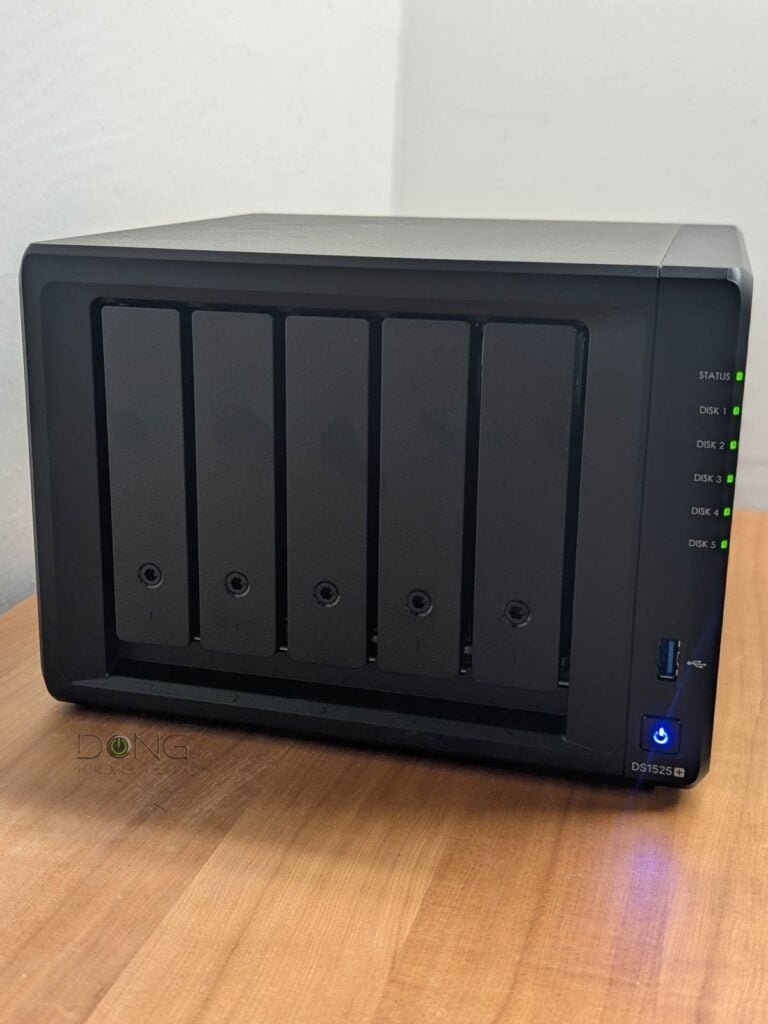
You may have noticed that I used drives of relatively modest capacities, yet the total cost is still close to $1,300. For testing, I used a few more drives than necessary, but the idea is that you need to spend a substantial amount, besides the cost of the server itself, before you can get this server up and running at its bare minimum. Most importantly, you would save between 25% and 60% of the cost if you could use third-party options, especially if you opt for SSDs.
It’s worth noting that, despite the high cost, Synology-branded drives are relatively dated. The SNV3410, for example, still uses the PCIe Gen 3 standard. To put things in perspective, we’ve had PCIe Gen 5 NVMe SSDs for a couple of years now.
However, using Synology hard drives has its advantages. I noted that the server was near silent. Its large ventilation fan produced a subdued humming sound, and there was no hard drive sound at all, even during heavy operation.


In terms of performance, the DS1525+ proved to be one of the fastest NAS servers I’ve tested, especially with a 10Gbps upgrade. Still, it never reached close to the top speed of a 10Gbps connection, likely due to the dated specifications of the drives mentioned above.
Synology DiskStation DS1525+'s Rating
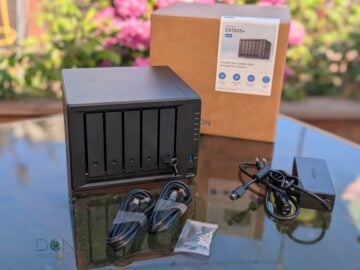
Pros
Dual 2.5GbE port with 10Gbps upgrade option; fast and reliable performance
Lots of useful home and business applications and storage options
Straightforward and consistent setup, upgrade, and management
Runs cool and quiet
Cons
USB ports remain at 5Gbps
Conclusion
While the DiskStation DS1525+ isn’t a must-have, it’s the only new 2025 Plus (+) server worth buying over the previous model it replaces. The new server is a solid multi-Gig upgrade with matching real-world performance, making it an excellent replacement for the previous over DS1522+. Consider it today!


When I buy things I expect them to be my property. A vendor that claims the right to override my property rights is gone!
Synology has crossed that line. It would be fine for them to warn me about unsupported disks, but to refuse to use the disks I select is ways over the line.
Dong it would be great if you could write an overview of the other potential NAS vendors to replace Synology.
Thanks
That’s a bit harsh. You can still use the server however you want, unlike like Amazon’s eero or TP-Link Deco and the likes, which only work when connected to the vendor. As for hardware lock-in, that’s the case with many other company, such as Apple, who doesn’t even allow you the right to repair. So, upsetting as it is, Synology is still the best brand for NAS.
Hopefully things will change. Until then you can simply get a pre-2025 model. It’ll last many years. But if you want alternative, I’d recommend giving UGREEN a try.
I had understood that the latest Synlogy NASs would not allow the use of non-Synology drives, is this incorrect?
Thanks for the vendor pointer.
Give this post a good read if you want to know the details.
As of today, 11/5/2025, this policy has been revoked. you can use othe Drives as before
Read the whole review, Paul! That information is highlighted above. Thanks for the input, though. 🙂
I have been about to buy my 4th Synology NAS but with the new policy of requiring their branded drives, I will never buy a Synology product again. I WAS a loyal customer. When you make changes like this, you should consider who loves you first.
WELL, Dean that won’t stop me from purchasing Synology NAS. The reason they implemented this is because they were getting lots of calls with issue with drives from other companies like Seagate. So you have issues now with new policies,drives, they are accountable.
As an owner of the DS1522+ with the 10Gbps extension port, it’s really nice to know that there is essentially no upgrade here, 3 years later. It’s unclear why someone would need more than one fast port. I’m using the 10Gbps one for the data access, and one of the 1Gbps ports for management (and even that, only because it’s available and I have free ports on my switches).
OTOH, it’s a bit disappointing that they did not bother to add a reasonably priced SFP+ extension option.
I think the new drive lock-in approach is a lot more disappointing. But I hear you.
Had I been in the market for a NAS today, I likely would have got Unifi’s UNAS-Pro, with two more bays and SFP+, and in the $350 price difference (including the 10GBps card) could get a really good mini PC that would run all my containers without fighting DSM’s restrictions…
Even without this absurd lock-in their offering wasn’t the best option.
UNAS Pro has much less in functionality for now. I’ll review their next model.